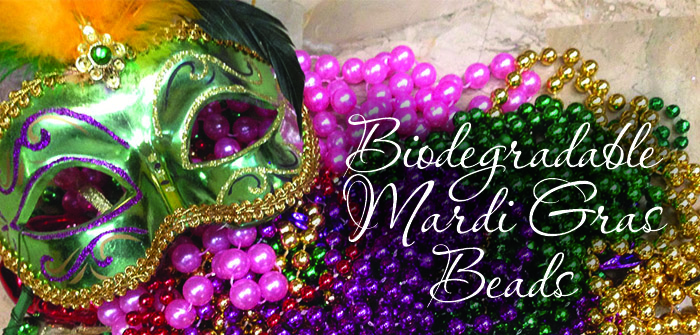Story by Mary Aho
One of the first things that comes to mind when you think of Mardi Gras is the thousands of colorful beads thrown and collected during the parades. Although, there are several other traditions, including the costumes, king cakes, and Krewes. “Throws” don’t just have to be beaded necklaces however; they are without a doubt,one of the most popular. While honoring these age-old traditions, Mardi Gras 2019 is looking for ways to be more sustainable and eco friendly. An LSU scientist is on his way to producing biodegradable Mardi Gras beads.
The Mardi Gras parades in New Orleans are believed to date back all the way to the 1830’s. These parades begin officially on January 6 and run throughout the carnival season. The carnival season ends on Fat Tuesday, the day before the start of lent. In 1872, a king of carnival named Rex was invented by a group of business men. Rex tossed sugar coated almonds to the crowd. The Mardi Gras “throws” are very similar to some of the English Renaissance era festival customs.
Later in the 1800’s, glass beads were used to make inexpensive necklaces to be tossed to the crowds. It is believed that the first person to use beads as part of their costume was a man dressed as Santa Claus. The beads were an instant hit and New Orleans residents and tourists alike quickly adopted adding the beaded necklaces to their costumes.
Over the years, many other “throws” have been tossed and passed out during parades. Krewes have been known to pass out toys, candies, doubloons, and cups. In the late 1970’s coconuts were even handed out to the crowds at the Mardi Gras parades. However, people feared the coconuts were a liability and would cause injury if thrown into the crowds. The group, Zulu, who started passing out the coconuts, fought back. In 1988, the governor of Louisiana, Edwin Edwards,passed the “coconut bill” stating thatcoconuts could be handed out with the beads during Mardi Gras.
Despite all the other goodies being tossed and handed out during the Mardi Gras parades, bead necklaces hail as the most popular to this day. Now,Mardi Gras beads can be found in all shapes, colors, and sizes. However, the most used colors remain the traditional Mardi Gras colors, purple, green, and gold. The Purple represents justice; the green represents faith; and the gold represents power.
With all these beads being thrown, it has produced quitea lot of waste. Last year, more than 46 tons of Mardi Gras beads were picked up and pulled from the city’s drain system. That is 93,000 pounds. An LSU Biological Sciences professor, Naohiro Kato is creating a way to cut back on all that waste. “I believe we can change and do better. We have great resources to make our Mardi Gras celebrations more sustainable and to protect our environment and health,” stated Kato in a news release. Kato is creating biodegradable Mardi Gras beads out of microalgae that will disintegrate over time. Kato thought about using the microalgae to make the Mardi Gras beads because it is one of the ingredients used in bioplastic production.
With all these traditions,New Orleans residents and tourist from around the globe continue to celebrate and enjoy Mardi Gras festivities annually. Whether that be with a piece of king cake or riding a float tossing beads. With the biodegradable beads in the making,we are on our way to a cleaner,more sustainable Mardi Gras celebration. So, grab a mask and join a Krewe and enjoy this carnival season.




